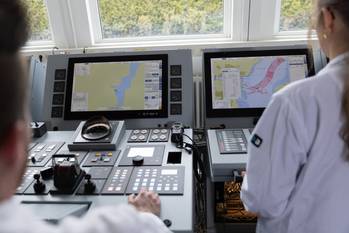Pod Propulsion
Pods are devices which combine both propulsive and steering functions in one device. They are usually located below the stern of a ship, making use of the following internal components: a fix pitch propeller, shaft, thrust and support bearings, brake, and shaft seals; exciter; AC motor (synchronous); bilge pump; and appropriate monitoring and control equipment. The steering unit uses slewing gears and is located in the hull above the pod itself. Lubrication equipment and ventilation/cooling units are usually located externally, as sub systems. Propulsion pods are not a new product, but a new configuration of traditional marine systems and components.
As yet, studies have not shown whether pods are more efficient than conventional shaft lines. There has been much research on the subject, but most studies have been aimed at a specific aspect of pod performance instead of an overall efficiency review. Several advantages have been attributed to pod propulsion systems, such as: reduced emissions, lower noise and vibration levels and emissions; improved steering maneuvering, and braking capabilities. The reduced number of component parts also allows for more flexibility in arranging system machinery, more efficient construction and improved shipyard logistics. On the opposite end of the argument, pods require a greater capital investment, have a 30MW power limitation (per screw), and have been known to suffer losses in power due to electric propulsion.

ZF Marine Debuts 4600 POD Propulsion System
Marine driveline specialist ZF announced it will premier its new 4600 POD Propulsion…

Superyacht ARTEFACT: A real “arte factum”
NOBISKRUG’s Project 790 is one of the first yachts built under the new strict IMO…

Shipbuilding: Inland Towing Thunderstruck
Eastern Shipbuilding offers the 4,200 hp Thunderbolt inland towboat designed around…

Thunderbolt: Eastern Delivers Innovative Towboat
Eastern Shipbuilding Group, Inc. introduced its new 120-ft., 4,200-hp Inland Towboat design…
Eastern Debuts ‘Thunderbolt’ Towboat
Eastern Shipbuilding Group, Inc. introduced its new 120-foot, 4,200-horsepower Inland…

Caterpillar Set to Showcase New Pod Propulsion Engine
Caterpillar Marine say they will unveil a significant product milestone at the 2013…

ZF Marine’s New Single POD Propulsion System
ZF Marine LLC, the North American division of the global ZF Marine Group, introduced…

Air Supported Monohull with Pod Propulsion
Effect Ships International AS, Sandefjord, Norway has just launched their first Air…
Royal Caribbean, Rolls-Royce Pod Settlement
Royal Caribbean Cruises Ltd. (NYSE, OSE: RCL) and Rolls-Royce announced that they…
STX Europe, New Order from French Navy
STX Europe has, through its subsidiary STX France Cruise SA, signed a contract to…
Siemens Equips Ships for Australia's Navy
Siemens Marine Solutions has been commissioned by the Spanish shipyard Navantia S.A.
Queen Mary 2 Commences Production With First Steel Cut
Pamela Conover, Cunard Line's president and COO, will make history today when she…
The global maritime industry is under immense pressure to meet ambitious climate targets, spearheaded by the International Maritime Organization (IMO)'s strategy to reach net-zero emissions by or around 2050. This mandate has triggered the most significant technological and financial upheaval the sector has ever faced. This article explores the core challenge—the decarbonization dilemma—focusing on the complex regulatory landscape (CII, ETS) and the intense, multi-fuel race to find viable, scalable, and safe "green fuels." We analyze the leading contenders—ammonia, methanol, and hydrogen—highlighting their pros, cons, and the colossal infrastructure investment required to power the future of global shipping.

The maritime industry, a cornerstone of global trade, is undergoing a significant transformation through the adoption of digitalization and smart shipping technologies. As the industry navigates the challenges of efficiency, sustainability, and safety, digital solutions are emerging as key drivers of change. From enhanced operational efficiency to real-time data analytics, digitalization is revolutionizing how ships and ports operate, paving the way for a smarter, more connected maritime future.
New propulsion systems reduce shipping emissions through several key mechanisms, contributing to lower fuel consumption, increased energy efficiency, and adoption of cleaner energy sources:1. Hybrid Propulsion SystemsHybrid systems combine traditional engines with electric motors and batteries…
Narco-submarines, the clandestine vessels used by drug traffickers, represent one of the most sophisticated and elusive methods of smuggling drugs across international waters. These semi-submersible and fully submersible crafts are a testament to the ingenuity and resourcefulness of criminal organizations in circumventing law enforcement efforts. This article delves into the history, construction, operation, and interdiction of narco-submarines, highlighting their impact on global drug trafficking.
Drug smuggling has long been a lucrative enterprise for criminal organizations worldwide. With the increasing sophistication of law enforcement agencies and border controls, smugglers are continuously adapting their methods. One of the most challenging trends to combat is the use of ships and submarines to transport illicit drugs across international waters. This article explores the methods, routes, and challenges associated with maritime drug smuggling.















